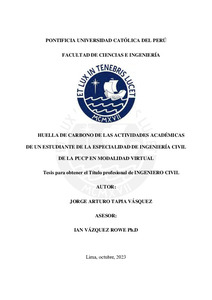| dc.contributor.advisor | Vázquez Rowe, Ian | |
| dc.contributor.author | Tapia Vásquez, Jorge Arturo | |
| dc.date.accessioned | 2024-02-13T13:56:28Z | |
| dc.date.available | 2024-02-13T13:56:28Z | |
| dc.date.created | 2023 | |
| dc.date.issued | 2024-02-13 | |
| dc.identifier.uri | http://hdl.handle.net/20.500.12404/27091 | |
| dc.description.abstract | A finales del 2019, el mundo se vio afectado por la aparición del virus SARS-CoV-2. Esto
conllevó a un aislamiento social obligatorio en muchos países. Únicamente los trabajos de
primera necesidad debían seguir asistiendo de forma presencial. La pandemia ocasionó que los
alumnos de la Pontificia Universidad Católica del Perú (PUCP), ubicada en Lima (Perú), lleven
sus cursos de manera virtual.
Ante esta nueva realidad, surge la necesidad de contrastar los diferentes valores de emisiones
de gases de efecto invernadero (GEI) generados en la modalidad presencial como en la
modalidad virtual. De esta forma analizar el efecto de las variaciones de las actividades que
realizaban los alumnos de la facultad de ingeniería civil.
Por tanto, este estudio analizará la huella de carbono de los estudiantes de la especialidad de
ingeniería civil de la PUCP en la modalidad virtual (se tomará como data la información del
año 2020) y se comparará con la modalidad presencial antes de la pandemia (se tomará como
data la información del año 2019).
En síntesis, la huella de carbono generada en las casas de estudios debe de ser siempre estudiada
y monitoreada. A diferencia de los demás estudios realizados en la modalidad presencial; con
el fin de, analizar, comparar y sacar conclusiones acerca de los GEI que estamos mitigando.
Por eso, con los resultados obtenidos, se observa que de la muestra tomada durante la pandemia
se ha emitido 63.05 t CO2 eq menos a comparación a un año normal de estudio. Sin embargo,
la energía eléctrica consumida durante un año de estudio virtual en pandemia es 2.5 veces
mayor a un ciclo presencial. Es importante dar a conocer la huella de carbono generada por la
modalidad virtual. Para finalmente, poder brindar posibles soluciones para la reducción de estas
emisiones. | es_ES |
| dc.description.abstract | Towards the end of the year 2019 the world was affected by the emergence of the SARS-COV-
2 virus. This phenomenon led to mandatory lockdowns throughout several countries. Frontline
workers were the only people that had to keep attending in person. The pandemic forced the
students from the Pontificia Universidad Católica del Perú (PUCP) located in Lima, Perú, to
continue their courses online.
From this new reality arose the necessity to contrast the different values for Greenhouse Gases
(GHG) issued from the virtual as well as in-person modality. Thus, to analyze the outcome of
the change in activities done by the students of the Civil Engineering faculty.
Therefore, this study will analyze the carbon footprint generated by the students of Civil
Engineering from PUCP within the virtual modality (for this purpose data from the year 2020
will be taken) and will be compared with the in-person before the pandemic (for this purpose
data from the year 2019 will be taken).
In short, the carbon footprint generated in universities must be studied and supervised, unlike
other studies carried for the in-person modality, in order to analyse, compare and to draw
conclusions of the greenhouse gases we are emitting. Therefore, with the results obtained from
the sample data taken during the pandemic, it shows that 63.05 tons less of CO2 eq has been
emitted during the pandemic in comparison to a full in-person modality year. Nevertheless, the
electric energy consumed during a year of online study amid the pandemic was 2.5 times than
a year of in-person modality. It is important to emphasize the carbon footprint generated by the
online modality. Thus, we can bring possible solutions to reduce these emissions. | es_ES |
| dc.language.iso | spa | es_ES |
| dc.publisher | Pontificia Universidad Católica del Perú | es_ES |
| dc.rights | info:eu-repo/semantics/openAccess | es_ES |
| dc.rights.uri | http://creativecommons.org/licenses/by/2.5/pe/ | * |
| dc.subject | Gases de efecto invernadero--Perú | es_ES |
| dc.subject | COVID-19 (Enfermedad)--Aspectos ambientales | es_ES |
| dc.subject | Educación a distancia | es_ES |
| dc.title | Huella de carbono de las actividades académicas de un estudiante de la especialidad de ingeniería civil de la PUCP en modalidad virtual | es_ES |
| dc.type | info:eu-repo/semantics/bachelorThesis | es_ES |
| thesis.degree.name | Ingeniero Civil | es_ES |
| thesis.degree.level | Título Profesional | es_ES |
| thesis.degree.grantor | Pontificia Universidad Católica del Perú. Facultad de Ciencias e Ingeniería | es_ES |
| thesis.degree.discipline | Ingeniería Civil | es_ES |
| renati.advisor.cext | 001084152 | |
| renati.advisor.orcid | https://orcid.org/0000-0002-7469-2033 | es_ES |
| renati.author.dni | 70825785 | |
| renati.discipline | 732016 | es_ES |
| renati.juror | Sanchez Matos, Joan | es_ES |
| renati.juror | Vazquez Rowe, Ian | es_ES |
| renati.juror | Deville Del Aguila, Alejandro | es_ES |
| renati.level | https://purl.org/pe-repo/renati/level#tituloProfesional | es_ES |
| renati.type | https://purl.org/pe-repo/renati/type#tesis | es_ES |
| dc.publisher.country | PE | es_ES |
| dc.subject.ocde | https://purl.org/pe-repo/ocde/ford#2.01.01 | es_ES |







